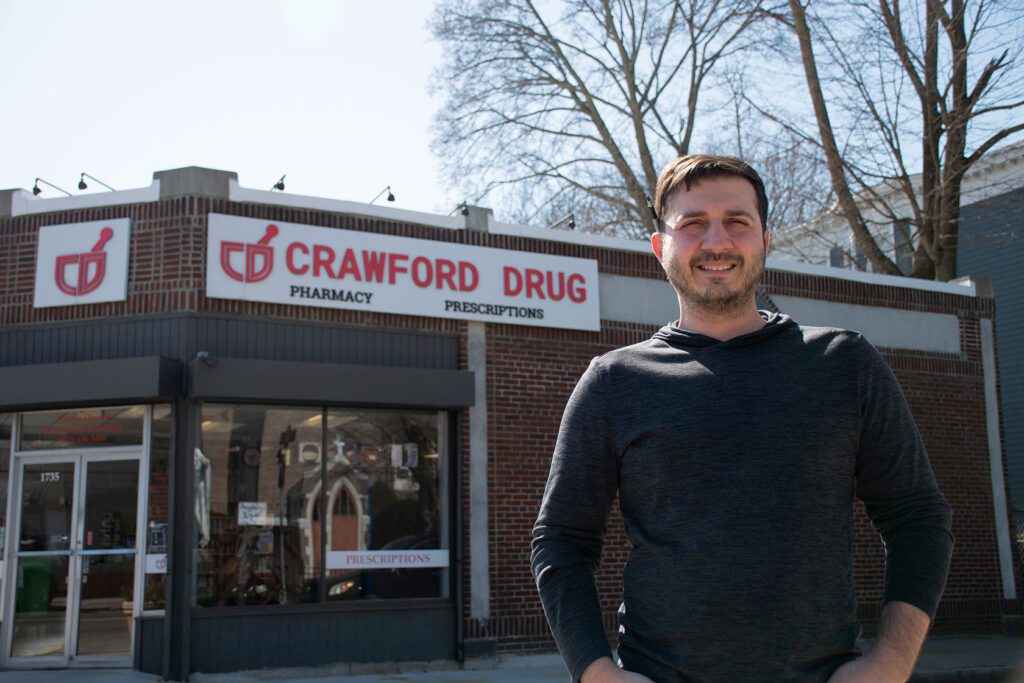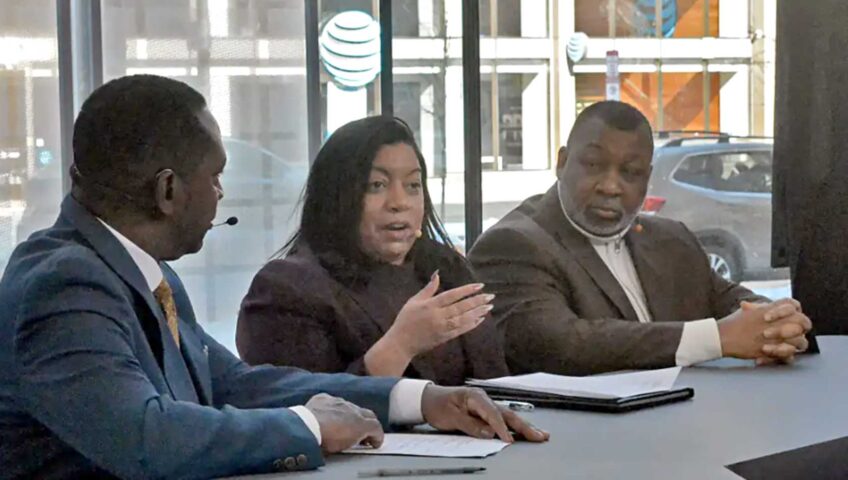
As big chain pharmacies shutter stores in Boston and across the country, local advocates are looking to independent pharmacy stores and community health centers to fill the gaps that are left behind.
In Boston, communities of color have, so far, felt the biggest hit from chain pharmacy store closures, seeing four in the past year and a half — two in Roxbury and one each in Mattapan and Hyde Park. Most recently, the Walgreens at 416 Warren St. shuttered at the end of January.
Supporters view independent pharmacies as a potential good fit to fill the gaps, especially in more diverse communities. The smaller stores often offer an expanded slate of services that chain stores may not, like better language access, special packaging, delivery services and more personalized care, said Todd Brown, executive director of the Massachusetts Independent Pharmacists Association.
Mike Wilson, the pharmacist who runs Crawford Drug near Ashmont, said those services can provide major support that keeps customers coming back. He said that Crawford Drug serves patients whose parents and grandparents came to the store before them.
“There’s a lot of unique needs for our elderly population here in the city and in the suburbs, [and] independent pharmacies traditionally fill those roles,” Wilson said.
Wilson also pointed to actions during the COVID-19 pandemic, when, he said, with fewer levels of management that needed to sign off, independent pharmacies could more easily jump into action to go into places like assisted living facilities and group homes to provide vaccines.
Brown estimated that there are about 100 independent pharmacies across the state — though he didn’t have an estimate for Boston specifically — and said he doesn’t think that number is going to drop.
“There’s always going to be a group of the population that wants a higher level of service that independent pharmacies provide,” Brown said.
Patient satisfaction surveys often indicate that consumers prefer the independent stores over the chain ones. A J.D. Power survey from 2023 found that satisfaction among customers was higher when they knew the name of their pharmacist or technician.
But the way pharmacies interact with insurance systems can get complicated and can present barriers to expansion for independent stores. Those challenges, Brown and Wilson said, come from pharmacy benefit managers — middlemen between drug companies, insurers and pharmacies.
In the current system, health plans pay pharmacy benefit managers to dispense drugs from the manufacturer. The benefit manager in turn is supposed to reimburse the pharmacy for the drugs.
But with pharmacy benefit managers acting as the access points to people covered by an insurance plan, Wilson said, pharmacies are often faced with “take-it-or-leave-it contracts,” where they can accept low reimbursement rates from the pharmacy benefit managers for medications or not have access to the patients covered under the contract.
“We really have no power to negotiate with them,” he said.
Those deals can make the pharmacies pay more for the drugs than they’re getting back from the benefit managers. Brown said it’s part of a system that builds profits for the pharmacy benefit managers and needs legislative intervention to address it at both the state and federal level.
Separately, Wilson said he’d like to see an expansion of the roles pharmacists can play for patients. With knowledge of medication, he said, independent pharmacists could provide increased guidance to patients around things like smoking cessation or birth control. But pharmacists should be able to bill insurance companies for the time it takes to sit down and consult with a patient, he added.
An expansion of pharmacy services isn’t new. Historically, a patient seeking a vaccine would go to a doctor, but over the past few decades, pharmacies have increasingly become a destination for that care. A 2022 literature review in the Journal of the American Pharmacists Association found that when pharmacists provided and advocated for patients to receive shots, vaccination rates increased.
Community health centers
Beyond mom-and-pop pharmacy stores, advocates are looking toward community health centers to close gaps.
Supporters point to health centers’ ability to offer a comprehensive system of care to patients as a big draw for supporting and expanding their pharmacy capacity.

Cars drive past Whittier Street Health Center in Roxbury in July 2023. Some advocates see community health centers as a way to fill gaps left by departing chain pharmacy stores. COURTESY PHOTO
“Can you imagine if every health center had a pharmacy that folks could go to? They could go get their health needs met and go walk right upstairs or downstairs to the pharmacy,” said the Rev. Miniard Culpepper, a leader of the Communities of Color Coalition for Health Equity, which pushed for the Warren Street Walgreens to remain open. “There would be no need for Walgreens or CVS.”
The model presents opportunities, but there’s a cost barrier for community health centers looking to start or expand pharmacy services.
At the Whittier Street Health Center in Roxbury, the facility has long had a pharmacy on site, but until recently those services were contracted out. In 2021, the health center made the switch and took over the pharmacy itself — a move that Whittier Street President and CEO Frederica Williams said helped bring those services into the integrated care system the center promotes, but required a major investment with fundraising and grants.
“There’s a need. I think there is a role and a place for community health centers, and I know many of us want to take on that challenge,” Williams said.
Beyond the takeover of the pharmacy at its main location, Williams said Whittier Street Health Center is currently looking at the feasibility of expanding pharmacy services to its satellite location on Blue Hill Avenue.
Community health centers already serve as a “critical part” of ensuring access to medication in communities of color, said Cheryl Clark, executive director and senior vice president at the Institute for Health Equity Research, Evaluation & Policy.
“It’s important to point out community health centers often do have onsite pharmacies, but they’re committed to being in the community,” Clark said. “They help communities to find access to these medications.”
Broader supports that already exist for qualified community health centers can help them offer pharmacy services, once the space is up and running.
One such boon comes in the form of the 340B drug pricing program, a federal system that allows providers that treat low-income and uninsured patients to purchase medications at a discount to distribute to their patients.
The 30-year-old program is designed to help providers reach financially vulnerable patients. But rapid expansion — according to a report from the University of Southern California, the number of covered entities in the program increased from about 8,000 to 50,000 between 2000 and 2020 — has caused pushback from drug companies, and the program has faced legal challenges.
“Though health centers have stepped forward, and for a long time supported these communities, there definitely needs to be other policies and processes put in place, and 340B is an important one of those,” Clark said.
At Whittier Street, Williams said that system has allowed their pharmacy to provide savings to patients or support other programs within the center, but it does create logistical considerations, as the pharmacy has to keep one supply of medications under the 340B program and another for its general retail pharmacy.
The city weighs in
The city of Boston has been in discussions to assess the state of the industry and determine how to address any gaps in pharmacy access if they appear.
In the wake of the closure of the Warren Street Walgreens, at the annual meeting of the Urban League of Eastern Massachusetts, Mayor Michelle Wu announced short-term plans to partner with the Urban League and Lyft to help transport residents impacted by the closure to nearby pharmacies.
For that partnership, the city identified six stores within a mile of the shuttered Walgreens. One was the Walgreens at Columbus Avenue and Washington Street, another was a CVS in Grove Hall, and the remaining four were independent stores or ones in community health centers, said Segun Idowu, chief of economic opportunity and inclusion for the city of Boston.
At the same time, Wu mentioned longer-term efforts to consider supporting an independent pharmacy to fill the gap left by the Warren Street Walgreens.
Idowu said that is a “longer conversation,” but the city is focused on ensuring that, as gaps in pharmacy access emerge, the city can facilitate getting independent pharmacies into those areas.
Culpepper said he would like to see increased city and state efforts to support these alternatives to chain stores, with programs focused on small business support to fill the gaps in communities.
“We need to be innovative about this and understand the reality of what’s happening,” he said.
He called efforts to expand the capacity of health centers and independent pharmacies “essential and necessary,” particularly as the city may face additional chain store closures.
Whittier Street’s Williams said she was on a call in mid-February with Wu and city officials from the Boston Public Health Commission and the Department of Economic Opportunity and Inclusion, as well as representatives from major pharmacy chains, to discuss the landscape for chain retail pharmacies. According to Williams, one takeaway was that more stores might be shuttered.
“The better prepared we are, the stronger we are,” she said.
Idowu said considering potential closures and what role independent stores can play needs to fit into a broader picture of an industry that is increasingly going to rely on delivery and online services — factors that he said chains like Walgreens and CVS have noted as they talk about closures.
Those same pressures can also impact independent pharmacies, and support for those stores should not just focus on expanding physical locations, but also considering how they can move forward as technology develops.
“Pharmacies are not a separate entity; they are small businesses too,” Idowu said. “All small businesses are going to be going through this … so I just think it’s important to have this conversation in the larger context as opposed to something that’s separate.”






